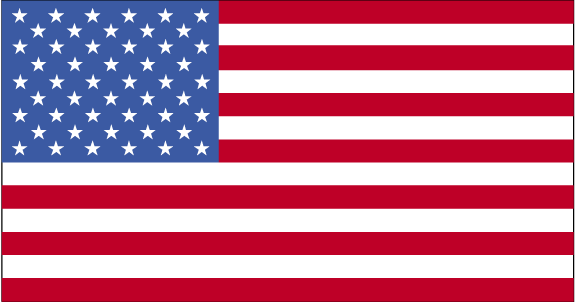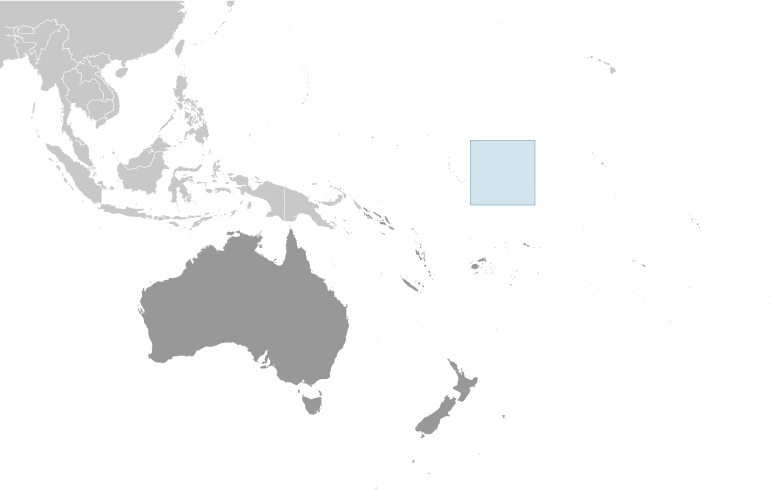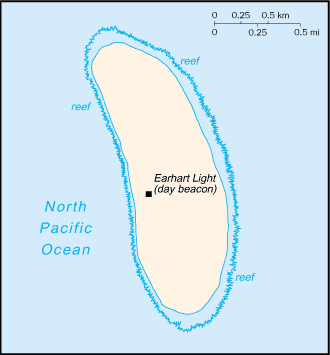Main Content
Australia - Oceania
::
Howland Island
Print
Page last updated on December 18, 2019
The World Factbook
Country/Location Flag Modal
Australia - Oceania ::
Howland Island
Print

Flag Description
the flag of the US is used
The World Factbook
Country/Location Locator Map Modal
Australia - Oceania ::
Howland Island
Print

The World Factbook
Country/Location Photo Gallery Modal
Australia - Oceania ::
Howland Island

1 /
1
Caption
Howland Island is a US possession located in the north Pacific between Australia and the Hawaiian Islands. Prior to 1890, organic nitrate (guano) was mined from the island by both the US and the British. This tiny island (2.6 sq km) is currently part of the US National Wildlife Refuge system, and provides nesting areas and forage for a variety of birds and marine wildlife.
Dimensions
File Size
Download
Usage
Factbook photos - obtained from a variety of sources - are in the public domain
and are copyright free.
Agency Copyright Notice
Agency Copyright Notice
- Jump to topic
-
Introduction :: Howland Island
-
Background: This entry usually highlights major historic events and current issues and may include a statement about one or two key future trends.
 Discovered by the US early in the 19th century, the island was officially claimed by the US in 1857. Both US and British companies mined for guano until about 1890. Earhart Light, a day beacon near the middle of the west coast, was partially destroyed during World War II, but subsequently rebuilt; it is named in memory of the famed aviatrix Amelia EARHART. The island is administered by the US Department of the Interior as a National Wildlife Refuge.
Discovered by the US early in the 19th century, the island was officially claimed by the US in 1857. Both US and British companies mined for guano until about 1890. Earhart Light, a day beacon near the middle of the west coast, was partially destroyed during World War II, but subsequently rebuilt; it is named in memory of the famed aviatrix Amelia EARHART. The island is administered by the US Department of the Interior as a National Wildlife Refuge. -
Geography :: Howland Island
-
Location: This entry identifies the country's regional location, neighboring countries, and adjacent bodies of water.
 Oceania, island in the North Pacific Ocean, about half way between Hawaii and AustraliaGeographic coordinates: This entry includes rounded latitude and longitude figures for the centroid or center point of a country expressed in degrees and minutes; it is based on the locations provided in the Geographic Names Server (GNS), maintained by the National Geospatial-Intelligence Agency on behalf of the US Board on Geographic Names.
Oceania, island in the North Pacific Ocean, about half way between Hawaii and AustraliaGeographic coordinates: This entry includes rounded latitude and longitude figures for the centroid or center point of a country expressed in degrees and minutes; it is based on the locations provided in the Geographic Names Server (GNS), maintained by the National Geospatial-Intelligence Agency on behalf of the US Board on Geographic Names. 0 48 N, 176 38 WMap references: This entry includes the name of the Factbook reference map on which a country may be found. Note that boundary representations on these maps are not necessarily authoritative. The entry on Geographic coordinates may be helpful in finding some smaller countries.
0 48 N, 176 38 WMap references: This entry includes the name of the Factbook reference map on which a country may be found. Note that boundary representations on these maps are not necessarily authoritative. The entry on Geographic coordinates may be helpful in finding some smaller countries. OceaniaArea: This entry includes three subfields. Total area is the sum of all land and water areas delimited by international boundaries and/or coastlines. Land area is the aggregate of all surfaces delimited by international boundaries and/or coastlines, excluding inland water bodies (lakes, reservoirs, rivers). Water area is the sum of the surfaces of all inland water bodies, such as lakes, reservoirs, or rivers, as delimited by international boundaries and/or coastlines.
OceaniaArea: This entry includes three subfields. Total area is the sum of all land and water areas delimited by international boundaries and/or coastlines. Land area is the aggregate of all surfaces delimited by international boundaries and/or coastlines, excluding inland water bodies (lakes, reservoirs, rivers). Water area is the sum of the surfaces of all inland water bodies, such as lakes, reservoirs, or rivers, as delimited by international boundaries and/or coastlines. Area - comparative: This entry provides an area comparison based on total area equivalents. Most entities are compared with the entire US or one of the 50 states based on area measurements (1990 revised) provided by the US Bureau of the Census. The smaller entities are compared with Washington, DC (178 sq km, 69 sq mi) or The Mall in Washington, DC (0.59 sq km, 0.23 sq mi, 146 acres).
Area - comparative: This entry provides an area comparison based on total area equivalents. Most entities are compared with the entire US or one of the 50 states based on area measurements (1990 revised) provided by the US Bureau of the Census. The smaller entities are compared with Washington, DC (178 sq km, 69 sq mi) or The Mall in Washington, DC (0.59 sq km, 0.23 sq mi, 146 acres). about three times the size of The Mall in Washington, DCLand boundaries: This entry contains the total length of all land boundaries and the individual lengths for each of the contiguous border countries. When available, official lengths published by national statistical agencies are used. Because surveying methods may differ, country border lengths reported by contiguous countries may differ.
about three times the size of The Mall in Washington, DCLand boundaries: This entry contains the total length of all land boundaries and the individual lengths for each of the contiguous border countries. When available, official lengths published by national statistical agencies are used. Because surveying methods may differ, country border lengths reported by contiguous countries may differ. 0 kmCoastline: This entry gives the total length of the boundary between the land area (including islands) and the sea.
0 kmCoastline: This entry gives the total length of the boundary between the land area (including islands) and the sea. 6.4 kmMaritime claims: This entry includes the following claims, the definitions of which are excerpted from the United Nations Convention on the Law of the Sea (UNCLOS), which alone contains the full and definitive descriptions: territorial sea - the sovereignty of a coastal state extends beyond its land territory and internal waters to an adjacent belt of sea, described as the territorial sea in the UNCLOS (Part II); this sovereignty extends to the air space over the territorial sea as well as its underlying s . . . more
6.4 kmMaritime claims: This entry includes the following claims, the definitions of which are excerpted from the United Nations Convention on the Law of the Sea (UNCLOS), which alone contains the full and definitive descriptions: territorial sea - the sovereignty of a coastal state extends beyond its land territory and internal waters to an adjacent belt of sea, described as the territorial sea in the UNCLOS (Part II); this sovereignty extends to the air space over the territorial sea as well as its underlying s . . . more territorial sea: 12 nmexclusive economic zone: 200 nmClimate: This entry includes a brief description of typical weather regimes throughout the year; in the Word entry only, it includes four subfields that describe climate extremes:ten driest places on earth (average annual precipitation) describes the annual average precipitation measured in both millimeters and inches for selected countries with climate extremes. ten wettest places on earth (average annual precipitation) describes the annual average precipitation measured in both millimeters and i . . . more
territorial sea: 12 nmexclusive economic zone: 200 nmClimate: This entry includes a brief description of typical weather regimes throughout the year; in the Word entry only, it includes four subfields that describe climate extremes:ten driest places on earth (average annual precipitation) describes the annual average precipitation measured in both millimeters and inches for selected countries with climate extremes. ten wettest places on earth (average annual precipitation) describes the annual average precipitation measured in both millimeters and i . . . more equatorial; scant rainfall, constant wind, burning sunTerrain: This entry contains a brief description of the topography.
equatorial; scant rainfall, constant wind, burning sunTerrain: This entry contains a brief description of the topography. low-lying, nearly level, sandy, coral island surrounded by a narrow fringing reef; depressed central areaNatural resources: This entry lists a country's mineral, petroleum, hydropower, and other resources of commercial importance, such as rare earth elements (REEs). In general, products appear only if they make a significant contribution to the economy, or are likely to do so in the future.
low-lying, nearly level, sandy, coral island surrounded by a narrow fringing reef; depressed central areaNatural resources: This entry lists a country's mineral, petroleum, hydropower, and other resources of commercial importance, such as rare earth elements (REEs). In general, products appear only if they make a significant contribution to the economy, or are likely to do so in the future. guano (deposits worked until late 1800s), terrestrial and aquatic wildlifeNatural hazards: This entry lists potential natural disasters. For countries where volcanic activity is common, a volcanism subfield highlights historically active volcanoes.
guano (deposits worked until late 1800s), terrestrial and aquatic wildlifeNatural hazards: This entry lists potential natural disasters. For countries where volcanic activity is common, a volcanism subfield highlights historically active volcanoes. the narrow fringing reef surrounding the island can be a maritime hazardEnvironment - current issues: This entry lists the most pressing and important environmental problems. The following terms and abbreviations are used throughout the entry: Acidification - the lowering of soil and water pH due to acid precipitation and deposition usually through precipitation; this process disrupts ecosystem nutrient flows and may kill freshwater fish and plants dependent on more neutral or alkaline conditions (see acid rain). Acid rain - characterized as containing harmful levels of sulfur dioxi . . . more
the narrow fringing reef surrounding the island can be a maritime hazardEnvironment - current issues: This entry lists the most pressing and important environmental problems. The following terms and abbreviations are used throughout the entry: Acidification - the lowering of soil and water pH due to acid precipitation and deposition usually through precipitation; this process disrupts ecosystem nutrient flows and may kill freshwater fish and plants dependent on more neutral or alkaline conditions (see acid rain). Acid rain - characterized as containing harmful levels of sulfur dioxi . . . more no natural fresh water resourcesGeography - note: This entry includes miscellaneous geographic information of significance not included elsewhere.
no natural fresh water resourcesGeography - note: This entry includes miscellaneous geographic information of significance not included elsewhere. almost totally covered with grasses, prostrate vines, and low-growing shrubs; small area of trees in the center; primarily a nesting, roosting, and foraging habitat for seabirds, shorebirds, and marine wildlife
almost totally covered with grasses, prostrate vines, and low-growing shrubs; small area of trees in the center; primarily a nesting, roosting, and foraging habitat for seabirds, shorebirds, and marine wildlife -
People and Society :: Howland Island
-
Population: This entry gives an estimate from the US Bureau of the Census based on statistics from population censuses, vital statistics registration systems, or sample surveys pertaining to the recent past and on assumptions about future trends. The total population presents one overall measure of the potential impact of the country on the world and within its region. Note: Starting with the 1993 Factbook, demographic estimates for some countries (mostly African) have explicitly taken into account t . . . more
 uninhabited
uninhabitednote: American civilians evacuated in 1942 after Japanese air and naval attacks during World War II; occupied by US military during World War II but abandoned after the war; public entry is by special-use permit from US Fish and Wildlife Service only and generally restricted to scientists and educators; visited annually by US Fish and Wildlife Service
-
Government :: Howland Island
-
Country name: This entry includes all forms of the country's name approved by the US Board on Geographic Names (Italy is used as an example): conventional long form (Italian Republic), conventional short form (Italy), local long form (Repubblica Italiana), local short form (Italia), former (Kingdom of Italy), as well as the abbreviation. Also see the Terminology note.
 conventional long form: noneconventional short form: Howland Islandetymology: named after the lookout on a whaling vessel who spotted the island in 1842Dependency status: This entry describes the formal relationship between a particular nonindependent entity and an independent state.
conventional long form: noneconventional short form: Howland Islandetymology: named after the lookout on a whaling vessel who spotted the island in 1842Dependency status: This entry describes the formal relationship between a particular nonindependent entity and an independent state. unincorporated territory of the US; administered from Washington, DC, by the Fish and Wildlife Service of the US Department of the Interior as part of the National Wildlife Refuge SystemLegal system: This entry provides the description of a country's legal system. A statement on judicial review of legislative acts is also included for a number of countries. The legal systems of nearly all countries are generally modeled upon elements of five main types: civil law (including French law, the Napoleonic Code, Roman law, Roman-Dutch law, and Spanish law); common law (including United State law); customary law; mixed or pluralistic law; and religious law (including Islamic law). An addition . . . more
unincorporated territory of the US; administered from Washington, DC, by the Fish and Wildlife Service of the US Department of the Interior as part of the National Wildlife Refuge SystemLegal system: This entry provides the description of a country's legal system. A statement on judicial review of legislative acts is also included for a number of countries. The legal systems of nearly all countries are generally modeled upon elements of five main types: civil law (including French law, the Napoleonic Code, Roman law, Roman-Dutch law, and Spanish law); common law (including United State law); customary law; mixed or pluralistic law; and religious law (including Islamic law). An addition . . . more the laws of the US apply where applicableFlag description: This entry provides a written flag description produced from actual flags or the best information available at the time the entry was written. The flags of independent states are used by their dependencies unless there is an officially recognized local flag. Some disputed and other areas do not have flags.
the laws of the US apply where applicableFlag description: This entry provides a written flag description produced from actual flags or the best information available at the time the entry was written. The flags of independent states are used by their dependencies unless there is an officially recognized local flag. Some disputed and other areas do not have flags. the flag of the US is used
the flag of the US is used -
Military and Security :: Howland Island
-
Military - note: This entry includes miscellaneous military information of significance not included elsewhere.
 defense is the responsibility of the US; visited annually by the US Coast Guard (2019)
defense is the responsibility of the US; visited annually by the US Coast Guard (2019) -
Transportation :: Howland Island
-
Roadways: This entry gives the total length of the road network and includes the length of the paved and unpaved portions.
 Ports and terminals: This entry lists major ports and terminals primarily on the basis of the amount of cargo tonnage shipped through the facilities on an annual basis. In some instances, the number of containers handled or ship visits were also considered. Most ports service multiple classes of vessels including bulk carriers (dry and liquid), break bulk cargoes (goods loaded individually in bags, boxes, crates, or drums; sometimes palletized), containers, roll-on/roll-off, and passenger ships. The listing le . . . more
Ports and terminals: This entry lists major ports and terminals primarily on the basis of the amount of cargo tonnage shipped through the facilities on an annual basis. In some instances, the number of containers handled or ship visits were also considered. Most ports service multiple classes of vessels including bulk carriers (dry and liquid), break bulk cargoes (goods loaded individually in bags, boxes, crates, or drums; sometimes palletized), containers, roll-on/roll-off, and passenger ships. The listing le . . . more none; offshore anchorage only; note - there is one small boat landing area along the middle of the west coastTransportation - note: This entry includes miscellaneous transportation information of significance not included elsewhere.
none; offshore anchorage only; note - there is one small boat landing area along the middle of the west coastTransportation - note: This entry includes miscellaneous transportation information of significance not included elsewhere. Earhart Light, a day beacon near the middle of the west coast, was partially destroyed during World War II but rebuilt during the 1960s; today it is crumbling and in poor repair; named in memory of famed aviatrix Amelia EARHART
Earhart Light, a day beacon near the middle of the west coast, was partially destroyed during World War II but rebuilt during the 1960s; today it is crumbling and in poor repair; named in memory of famed aviatrix Amelia EARHART -
Transnational Issues :: Howland Island
-
Disputes - international: This entry includes a wide variety of situations that range from traditional bilateral boundary disputes to unilateral claims of one sort or another. Information regarding disputes over international terrestrial and maritime boundaries has been reviewed by the US Department of State. References to other situations involving borders or frontiers may also be included, such as resource disputes, geopolitical questions, or irredentist issues; however, inclusion does not necessarily constitute . . . more

none




